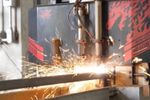Water is the agriculture industry’s best friend – and worst enemy. It is essential for growing crops and feeding livestock, yet it is also detrimental if it seeps into a poultry fat tank or a feed and grain bulk storage silo.
It only takes 12 percent moisture content inside a feed storage container to develop condensation that leads to grain caking. Moisture can also inflict serious rust damage to the surface of a storage bin and quickly compromise the integrity of all the product inside.
Fortunately, there are multiple metal fabrication and finishing techniques to protect the integrity of steel storage structures, offering long-term protection even during extreme climate changes that expose steel to water and fluctuating temperatures.
The first step to protecting the steel’s surface begins with the right metal fabrication design.
Metal Fabrication Design Considerations
When looking at bulk storage design, surface thickness will vary, depending on the type of wet or dry contents being housed inside. Surface thickness can impact the functionality of sub-assemblies and components. Parts with overlapping surfaces can cause any surface coating to wear more quickly.
Build storage design considerations may include:
- The type of steel selected, as each type has different metallurgical properties that react differently to hot-dip galvanizing or other coatings.
- Proper venting and drainage to allow for a consistent and even coating.
- Welding requirements, which can impact how coatings will adhere to welded areas.
Welding Considerations
For many metal-fabricated bulk storage containers, steel detailing such as spot or metal arc welding is required to fuse silo or hopper parts together prior to hot-dip galvanizing or other coating. But if welding is not performed with these specific coating processes in mind, the welds may not hold.
Properly certified welders will take precautions to prevent the zinc from penetrating the weld spot that can lead to cracking. A pushing weld, rather than a pulling weld, can help ensure the spot will remain intact during the galvanizing process.
HDG & Other Coating Considerations
One of the most effective ways to increase the longevity of a steel silo or other bulk storage container is to coat the steel’s surface via hot-dip galvanizing (HDG). Also referred to as batch or after-fabrication galvanizing, HDG is a coating process to line the steel in corrosion-resistant zinc.
Coating success depends on the design and welding considerations noted above, as well as:
- How effectively the fabricated metal surface is cleaned to remove grease, oils, and mill scale.
- How the fabrication is dipped in the kettle of molten pure zinc and additives, as the coating must surround every edge and crevice.
- How much time the zinc bath is given to react to the steel at a metallurgic level and form the corrosion-protective coating.
It is also important to assess the structural condition of a steel hopper or silo to take into account any existing strain-age embrittlement or working parts that may experience undue friction. After HDG, welding must be performed with care to avoid damaging the zinc coating.
Metal Fabrication Custom Finishing for Bottom-Line Results
At Southern Metal Fabricators, we have spent decades fabricating bulk storage solutions for the agriculture industry, including steel feed and grain silos and hoppers that can endure even the harshest outdoor conditions.
Our full-service custom metal finishing shop offers everything from surface preparation to final finishing. Our engineers understand how to counteract corrosion threats via quality surface preparation, hot-dip galvanizing, metal powder coating, and/or painting.
Because we have more than 28 years of experience working with agriculture, feed & grain, and bulk food storage, we are ready to say, “Yes, we can do that!” Contact us today.





